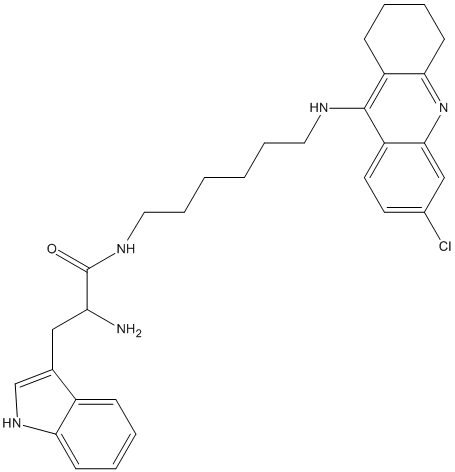Chlorotacrine-tryptophan-hybrid
IC50 values of 6.3nM human AChE and 9.1nM human BChE. inhibit Abeta42 self-aggregation (58.6+/-5.1% at 50muM) as well as hAChE-induced Abeta40 aggregation (48.3+/-6.3% at 100muM)
General
Type : Derivative of Tacrine,Multitarget,Indole,anti-Abeta-aggregation,Alkyl linked bis-ligand
Chemical_Nomenclature : (2~{S})-2-azanyl-~{N}-[6-[(6-chloranyl-1,2,3,4-tetrahydroacridin-9-yl)amino]hexyl]-3-(1~{H}-indol-3-yl)propanamide
Canonical SMILES : C1CCC2=NC3=C(C=CC(=C3)Cl)C(=C2C1)NCCCCCCNC(=O)C(CC4=CNC5=CC=CC=C54)N
InChI : InChI=1S\/C30H36ClN5O\/c31-21-13-14-24-28(18-21)36-27-12-6-4-10-23(27)29(24)33-15-7-1-2-8-16-34-30(37)25(32)17-20-19-35-26-11-5-3-9-22(20)26\/h3,5,9,11,13-14,18-19,25,35H,1-2,4,6-8,10,12,15-17,32H2,(H,33,36)(H,34,37)\/t25-\/m0\/s1
InChIKey : MSZVAOQNSCIOAB-VWLOTQADSA-N
Other name(s) : 9A5
MW : 518.09
Formula : C30H36ClN5O
CAS_number :
PubChem : 134129088
UniChem : MSZVAOQNSCIOAB-VWLOTQADSA-N
IUPHAR :
Wikipedia :

Target
Families : Chlorotacrine-tryptophan-hybrid ligand of proteins in family: ACHE || BCHE
Stucture :
Protein : torca-ACHE || human-BCHE
References (1)
| Title : Novel tacrine-tryptophan hybrids: Multi-target directed ligands as potential treatment for Alzheimer's disease - Chalupova_2019_Eur.J.Med.Chem_168_491 |
| Author(s) : Chalupova K , Korabecny J , Bartolini M , Monti B , Lamba D , Caliandro R , Pesaresi A , Brazzolotto X , Gastellier AJ , Nachon F , Pejchal J , Jarosova M , Hepnarova V , Jun D , Hrabinova M , Dolezal R , Karasova JZ , Mzik M , Kristofikova Z , Misik J , Muckova L , Jost P , Soukup O , Benkova M , Setnicka V , Habartova L , Chvojkova M , Kleteckova L , Vales K , Mezeiova E , Uliassi E , Valis M , Nepovimova E , Bolognesi ML , Kuca K |
| Ref : Eur Journal of Medicinal Chemistry , 168 :491 , 2019 |
| Abstract : Chalupova_2019_Eur.J.Med.Chem_168_491 |
| ESTHER : Chalupova_2019_Eur.J.Med.Chem_168_491 |
| PubMedSearch : Chalupova_2019_Eur.J.Med.Chem_168_491 |
| PubMedID: 30851693 |
| Gene_locus related to this paper: torca-ACHE |